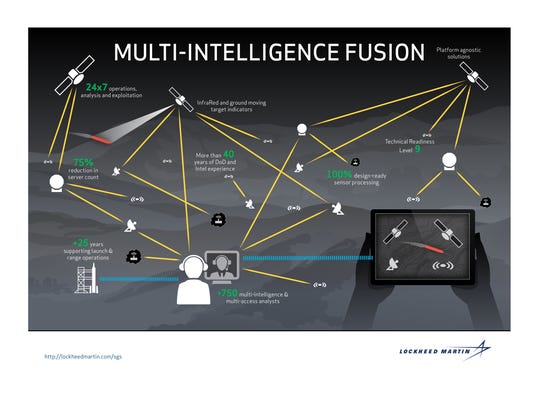 |
| A diagram showing how Multi-INT works. (Photo: Lockheed Martin) |
spendergast: Army CERDEC seeks Multi-modal Signal and Fusion Processor Architectures
ABERDEEN PROVING GROUND, Md., 27 Feb. 2015. U.S. Army
researchers are reaching out to industry for new ways to speed
actionable intelligence to the field commanders and warfighters on the
front-lines who need it most.
To do this, researchers are asking industry for ideas on creating a
common electronic architecture for performing multi-modal fusion within
signal processors, on the payload of sensor platforms, on maneuvering
vehicles, and at fixed site locations.
Officials of the Army Communications-Electronics Research,
Development and Engineering Center at Aberdeen Proving Ground, Md., have
issued a request for information (W56KGU-15-R-A025) for the Multi-modal
Signal and Fusion Processor project.
This initiative seeks new ideas for a common architecture that can
fuse information from several different kinds of battlefield sensors.
This common architecture for sensor fusion,
furthermore, could function within signal processors, on sensor
payloads, on maneuvering vehicles and aircraft, and at fixed-site
locations.

[GA-ASI Chris] Pehrson: There are more platforms and more sensors collecting more
data than at any time in history. The greatest challenge to C4ISR will
be distilling this sea of data to produce accurate, reliable, timely,
and actionable intelligence.
General Atomics Aeronautical Systems (GA-ASI) Remotely Piloted Aircraft (RPA) systems compound this challenge
because our Predator
®/Gray Eagle-series aircraft are flying
in greater numbers, with more endurance, and with
sensor payloads that
collect exponentially increasing amounts of data.
Our vision is to fuse Multi-INT data such as Full-motion Video,
Synthetic Aperture Radar/Ground Moving Target Indicator radar, and
SIGINT in order to reduce the workload of intelligence analysts on the
ground. We also envision networked platforms working collaboratively in
real-time to support ISR requirements.
 |
| Chris Pehrson |
Chris Pehrson serves as director of strategic development for
General Atomics-Aeronautical Systems Inc.,
where he is responsible for business acquisition strategies to
promote company’s unmanned aircraft systems, tactical reconnaissance
radars and sensor systems in U.S. and international markets.
Pehrson joined the company in 2010 after service in the
U.S. Air Force,
where he commanded an operations group and two squadrons as well as
completed staff tours at Air Force headquarters and the Office of the
Secretary of Defense.
GA-ASI - build it and they will come:
Pehrson: Because GA-ASI is a privately-held company, we are more agile
than most aerospace defense companies. We can take a longer view of
market opportunities and generally have more flexibility when investing
Internal Research and Development (IRAD) resources. For example, when we
introduced the U.S. Air Force to Predator B in 2001, and subsequently
Predator C in 2009, there was no government funding for aircraft
development. GA-ASI saw capability gaps, produced aircraft to fill those
gaps, and introduced fully mission capable RPA to the U.S. government
as an off-the-shelf solution. Both aircraft proved highly capable, which
led to further procurement, but we assumed development risk and
maintained an aggressive schedule because of our unique position in the
marketplace. Incentivizing a long-term perspective with rapid
acquisition processes is one way the government could stimulate
innovation and improve the way it purchases C4ISR goods and services.
Related/Background:




No comments:
Post a Comment